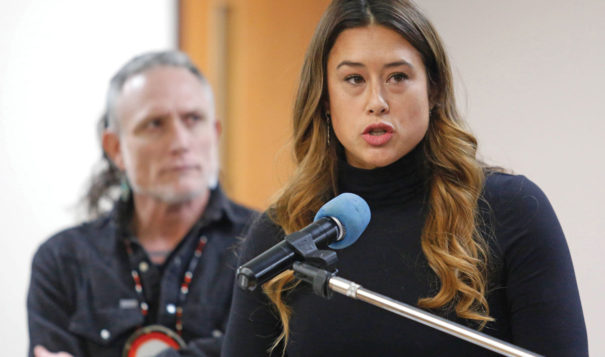News Article Article pages that do not meet specifications for other Trust Project Type of Work labels and also do not fit within the general news category.
Survey finds few tribal governments allow press freedom
 Editorial Board members MIa Prickett, front and Monty Herron make a presentation during the Tribal Council meeting in the Community Center on Sunday, Dec.2.
Editorial Board members MIa Prickett, front and Monty Herron make a presentation during the Tribal Council meeting in the Community Center on Sunday, Dec.2.
83% of respondents said stories about tribal government affairs often go unreported due to censorship.
Grand Ronde tribal citizen Mia Prickett used to assume she was reading unbiased reporting in the tribe’s newspaper, Smoke Signals. But all that changed when the tribal council disenrolled her and more than 80 of her relatives in 2013, effectively taking away their tribal citizenship.
“I had no reason to think that council or anybody had an undue influence on the paper,” Prickett, then a journalism student at the University of Oregon, said. She describes herself as naive for believing that the tribe’s newspaper reported all the facts and considered different points of view. She was proved wrong when Smoke Signals failed to tell her family’s side of the story.
Grand Ronde tribal leaders have come a long way from once dictating news content in the tribal newspaper. In December 2016, the tribal council passed an independent press ordinance, making it one of just three tribes the Native American Journalists Association, or NAJA, recognizes for having a viable press ordinance. (Full disclosure: HCN Associate Editor Tristan Ahtone is president of NAJA and was not involved in the editing of this story.)
In a Native media report I wrote for the Democracy Fund, I describe data showing that the majority of newspaper and radio stations are owned by tribal governments. That is problematic, because ownership means tribal leaders can, and often do, control content. In a 2018 NAJA press freedom survey, 83% of respondents said stories about tribal government affairs sometimes, frequently or always go unreported due to censorship.
Chris Mercier was among the Grand Ronde tribal members who noticed Smoke Signals’ failure to tell the full story about the disenrollments. Mercier, who earned a journalism degree from the University of Oregon in 1998, became a key advocate for tribal press freedom and was elected to the Grand Ronde Tribal Council in 2004.
In March, Staci Cummins and Anne Loyer, two students, from Harvard University’s Nation Building class, and I discussed freedom of the press with the Grand Ronde editorial board and staff. The tribe’s disenrollment debacle ultimately spurred the paper to seek independence.
Smoke Signals editor Dean Rhodes remembers the pre-ordinance days, when he followed council leaders’ orders to keep his job. “If we had written any story that would have even been close to being viewed as sympathetic to the cause of Mia’s family, Siobhan and I would have probably been fired,” he said. His comment led the editorial board members seated at the table to erupt in laughter. “I don’t even think that’s probably,” said Prickett. “I would say that would be 100 percent.”
The Grand Ronde independent press ordinance declares that Smoke Signals must be “free from any undue influence, and free from any particular political interest.” The ordinance, which was enacted 29 months ago, has kept council members and administration staff from interfering with content. “They’ve been totally taken out the equation,” Rhodes said.
Editorial board member Monty Herron recalled adjusting to the new independence, reminding council members: “Hey, by the way, you guys need to hire your own publicist again, because we’re not doing your job for you anymore,” said Herron. “We’re not going to be the mouthpiece of the council.” In 2018, the tribe hired its own deputy press secretary.
The influence of tribal leaders on tribe-owned media is apparent in a number of cases, according to a preliminary Red Press Initiative survey from 2018. (A second survey to help define the perceptions of independent media in Indian Country for consumers and producers of tribal media can be taken here.) In reply to a question about how government officials influence media coverage, one person wrote, “Tribal officials have complete control over our tribal media.” Another noted: “Again, a lot of news is pretty much censored by tribal administrators and entities. We need more independent journalists who can report on the news without watering down stories or following the dictates of tribal governments.”
One example of an independent press is the Navajo Times. I recently interviewed Navajo Times Editor Tom Arviso about freedom of the press and his role in securing editorial and financial independence from the Navajo Nation Council. The newspaper now stands as an independent, for-profit corporation of the Navajo Nation, paying its own bills through advertising revenue, subscriptions and display ads. “It’s not the government that owns the paper,” said Arviso. “It’s the Navajo people.”
May marks Arviso’s 31st year of employment at the Navajo Times. In the course of his career, he has faced bomb threats, been physically threatened, been suspended — even seen the newspaper shut down for months. He and his staff have reported on tribal corruption, including the imprisonment of former Navajo Chairman Peter MacDonald, who was convicted of riot, bribery, fraud, extortion and corruption.
The New York Times described the Navajo Times as an “aggressive newspaper” whose stories led to the resignation of Navajo Chairman Albert Hale in 1998. Hale faced potential criminal charges for misspending tribal money.
Grand Ronde tribal leaders took a critical step to better inform their tribal citizens with uncensored news when they enacted an independent press ordinance. By doing so, they have raised their level of accountability to those who matter most — the tribal citizens who elected them.
Jodi Rave is the executive director of the Indigenous Media Freedom Alliance, a nonprofit media organization that advocates for freedom of information and independence of tribal media. The IMFA also publishes www.buffalosfire.com.
